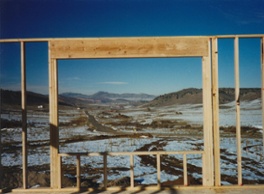No More “Damn Architects!” – The Case for Integrated Design

 In 1997, I helped my parents design and build their home. Early in the construction process, I had suggested that the house be built 25 feet back from where we originally had it planned, and that the fireplace be moved to the back side of the living room. We had already put the stakes in the ground and were ready to start digging for the foundation, but now we had to take the time to move them. Sarcastically, my mother said, “damn architects!”
In 1997, I helped my parents design and build their home. Early in the construction process, I had suggested that the house be built 25 feet back from where we originally had it planned, and that the fireplace be moved to the back side of the living room. We had already put the stakes in the ground and were ready to start digging for the foundation, but now we had to take the time to move them. Sarcastically, my mother said, “damn architects!”
In 1997, I helped my parents design and build their home. Early in the construction process, I had suggested that the house be built 25 feet back from where we originally had it planned, and that the fireplace be moved to the back side of the living room. We had already put the stakes in the ground and were ready to start digging for the foundation, but now we had to take the time to move them. Sarcastically, my mother said, “damn architects!”
The house was at one end of a mountain valley in the foothills of Northern Colroado, and at the other end of the valley was Horsetooth Mountain. During the Summer, they could watch the afternoon storms roll across the valley, and would often see heards of elk and deer roaming. The wildlife would practically dine with us, they were so close.
 My Mother knew that I had heard that exclamation a lot. Unfortunately, it was (and still is) common to want to point a finger at another trade because a decision they made caused a major change in the overall design and construction. Typically, the root cause of this is a break in communication or lack of an integrated design approach. In the case of my parents, we had been working together on design from when the thought of building a new home entered their minds. In fact, we worked together all through construction (my step-father was the builder), and the suggestion to move the house and fireplace came out of a group discussion about how to best take advantage of the view toward Horsetooth Mountain.
My Mother knew that I had heard that exclamation a lot. Unfortunately, it was (and still is) common to want to point a finger at another trade because a decision they made caused a major change in the overall design and construction. Typically, the root cause of this is a break in communication or lack of an integrated design approach. In the case of my parents, we had been working together on design from when the thought of building a new home entered their minds. In fact, we worked together all through construction (my step-father was the builder), and the suggestion to move the house and fireplace came out of a group discussion about how to best take advantage of the view toward Horsetooth Mountain.
Starting the design process with the entire project team working together to make all the decisions can save a project, as well as the sanity and reputation of all those involved. The unfortunate thing is, many buildings are not created this way, and fingerpointing is the least of the problems. It’s the homeowner or building owner that pays the price by not getting a building that performs the way they expected.
 Our blog is full of posts about how project teams miss opportunities to make a building perform well. Some great examples of this explain where it’s not a good idea to put certain light fixtures and duct work. These could have (and should have) been avoided if the project team had integrated their individual roles on the project to come up with a way to prevent failures or holes in the design. Serious home performance issues (e.g. infiltration and heat loss/gain), offensive aesthetic and functional problems (e.g. ductwork through an otherwise perfectly good closet), and major conflicts during the process are usually the result of a project that doesn’t use an integrated approach.
Our blog is full of posts about how project teams miss opportunities to make a building perform well. Some great examples of this explain where it’s not a good idea to put certain light fixtures and duct work. These could have (and should have) been avoided if the project team had integrated their individual roles on the project to come up with a way to prevent failures or holes in the design. Serious home performance issues (e.g. infiltration and heat loss/gain), offensive aesthetic and functional problems (e.g. ductwork through an otherwise perfectly good closet), and major conflicts during the process are usually the result of a project that doesn’t use an integrated approach.
Having every member of the project team on the same page and contributing to the design and construction process results in well thought out, comprehensive solutions that avoid compromising the design or performance integrity of the building. Plus, we can avoid having to work with all these “damn tradespeople!”
This Post Has 4 Comments
Comments are closed.

This is especially the case
This is especially the case in my primary trade, Timber Framing. We almost always get brought in a bit late and the timber frame has to fit into the already designed house. It always works better to let the two evolve together. HVAC is one of the trades that then comes into conflict with the timber frame. If the timber frame designer is not paying attention to the HVAC system, it can be tough in the end.
Clients often get sick of paying for design, because they want to see something built, not drawn. But money spent on good, thoughtful design, is always saved in the long run. I strongly believe that good integrated design not only creates a better home, but will save the client money and make more money for the trades at the same time.
RESPONSE TO DAN:
RESPONSE TO DAN:
I don’t like to hear that your parents had to “settle” for anything. It is their house, and they should have it the way they want it. There are a million ways to do the same thing, and it doesn’t always mean spending more money to get it. I’m sure if they only knew then what they know now, they may have figured a way to not have to settle.
RESPONSE TO SAM:
RESPONSE TO SAM:
Great thoughts, Sam! I’ve often heard the architect referred to as the “conductor”, because he/she oversees the orchestra of tradespeople/consultants to produce a masterpiece. This, as you know, does not always happen the way it should. It seems inevitable that at some point, maybe it’s during the intro or the finale, one instrument starts playing its own piece of music, and then, chaos!
Some people are better at playing along than others, but to serve our clients we have to all be on the same sheet of music. Buildings, like symphonies, can be extremely complicated, and they need all eyes and ears to make it come together smoothly!
Thanks, Sam!
RESPONSE TO STEPHEN: 
RESPONSE TO STEPHEN:
Thanks, Stephen!
I think you summed it up pretty well, that the key to a truly successful project is taking the time in the beginning to save in long run. Of course, its impossible to predict what might get overlooked along the way, but with a thoughtful approach, you can certainly plan for it.
One key area you called out, HVAC Design, can be the biggest thorn in a project’s side. But, it doesn’t have to be. It can be part of a great solution.
What seems complicated can be made simple when all the minds are working together to come up with a solution. More often than not, the solution not only works, but is beautiful!